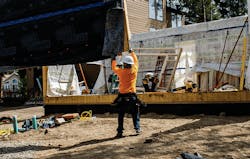5 Things Builders Can Borrow from 2021’s Solar Decathlon Homes
Whether you’ve been a regular or occasional follower of the U.S. Department of Energy’s Solar Decathlon competition, you will definitely notice something different about this year’s solar homes.
First of all, you won’t find them in a show home village on the National Mall in Washington, D.C., as in years past. “When, with covid, it became clear we were not going to have it on the mall or meet in person, all the teams transitioned to the local build option and engaged with their community,” says Holly Carr, director of the Solar Decathlon, which is a competition to design, build, and operate solar homes. This year, nine university teams involving hundreds of students from the U.S., Canada, Europe, and South America participated.
And, like professional builders, the Solar Decathlon teams faced unprecedented challenges as they tried to build their homes. “They had school cancelled. They couldn’t get access to the site. They couldn’t get materials. They had companies [they were working with] that went out of business,” says Carr, who praised the “incredible effort” of the students.
The pandemic-related decision to build locally, rooted in practicality, has resulted in a very different collection of solar homes, which also have quickly become rooted in the cities, towns, and neighborhoods where they were built. “It has been a game changer,” Carr says. “All of the homes are being built. Most are completed. Some are occupied. Some are furnished. And all of the homes have a plan for who will be living in them or what will happen to them after they are finished.”
Built by university student teams in the U.S. and abroad, the this year's solar homes demonstrate just how far energy efficiencies, renewables, and other high-performance building technology have come since 2002, when the first Solar Decathlon was held.
“These technologies are becoming more mainstream,” Carr says, pointing to the example of LED lightning. “You don’t have to do crazy things or use crazy technology to get to a net zero home.”
Whether you want to build a solar home, a zero energy home, or just improve your houses and building practices, here are five strategies worth borrowing, courtesy of this year’s Solar Decathlon homes.
- Cold-climate heat pumps. “We’ve been including these for years to get to all electric,” Carr says. “This year, they were used by teams in Waterloo [Ontario], Boulder [Colo.], and Ogden [Utah], all of which have very cold winters. But cold-climate heat pumps have evolved to the point where you can do that.”
- Smart home technologies. “In 2015 and 2017, this was cool, but now the University of Illinois house has Alexa-integrated smart home technology,” Carr notes. That same house also features a mobile app that automates the home’s appliances while helping the homeowner to track and manage energy use.
- Prefabrication. Depending on the house, teams turned to off-site built components such as panelized wall construction or structural insulated panels to save on labor, time, and costs while boosting the home’s energy efficiency.
- Electric vehicle charging stations. With more than 296,000 electric vehicles sold in the U.S. in 2020, more and more homeowners are looking for a place to plug in their car, whether it’s a Prius or a Tesla. The Weber State University team included a charging station in the detached garage of its family-friendly Utah house.
- Home batteries. For an electric home with solar, a home battery that stores energy for emergency usage is a better alternative than a gas-fueled generator; many ultra energy efficient homes are all electric, with no gas utility connection.
For virtual tours of the Solar Decathlon homes and more information on the building science behind the different houses, visit the Solar Decathlon site.
